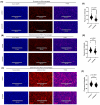Prolactin Drives Iron Release from Macrophages and Uptake in Mammary Cancer Cells through CD44
- PMID: 39201626
- PMCID: PMC11354873
- DOI: 10.3390/ijms25168941
Prolactin Drives Iron Release from Macrophages and Uptake in Mammary Cancer Cells through CD44
Abstract
Iron is an essential element for human health. In humans, dysregulated iron homeostasis can result in a variety of disorders and the development of cancers. Enhanced uptake, redistribution, and retention of iron in cancer cells have been suggested as an "iron addiction" pattern in cancer cells. This increased iron in cancer cells positively correlates with rapid tumor growth and the epithelial-to-mesenchymal transition, which forms the basis for tumor metastasis. However, the source of iron and the mechanisms cancer cells adopt to actively acquire iron is not well understood. In the present study, we report, for the first time, that the peptide hormone, prolactin, exhibits a novel function in regulating iron distribution, on top of its well-known pro-lactating role. When stimulated by prolactin, breast cancer cells increase CD44, a surface receptor mediating the endocytosis of hyaluronate-bound iron, resulting in the accumulation of iron in cancer cells. In contrast, macrophages, when treated by prolactin, express more ferroportin, the only iron exporter in cells, giving rise to net iron output. Interestingly, when co-culturing macrophages with pre-stained labile iron pools and cancer cells without any iron staining, in an iron free condition, we demonstrate direct iron flow from macrophages to cancer cells. As macrophages are one of the major iron-storage cells and it is known that macrophages infiltrate tumors and facilitate their progression, our work therefore presents a novel regulatory role of prolactin to drive iron flow, which provides new information on fine-tuning immune responses in tumor microenvironment and could potentially benefit the development of novel therapeutics.
Keywords: CD44 upregulation; iron transfer; macrophages; mammary cancer cells; prolactin.
Conflict of interest statement
The authors declare no conflicts of interest.
Figures







References
-
- Das B.K., Wang L., Fujiwara T., Zhou J., Aykin-Burns N., Krager K.J., Lan R., Mackintosh S.G., Edmondson R., Jennings M.L., et al. Transferrin receptor 1-mediated iron uptake regulates bone mass in mice via osteoclast mitochondria and cytoskeleton. elife. 2022;11:e73539. doi: 10.7554/eLife.73539. - DOI - PMC - PubMed
MeSH terms
Substances
Grants and funding
LinkOut - more resources
Full Text Sources
Medical
Research Materials
Miscellaneous

